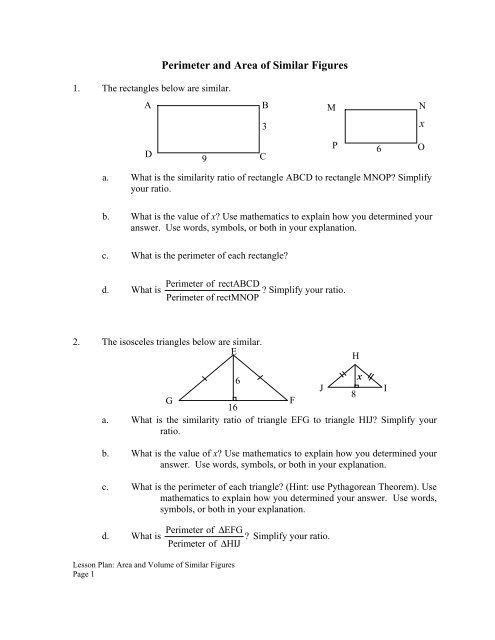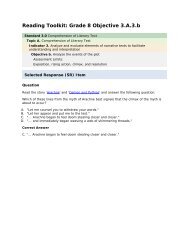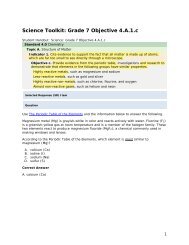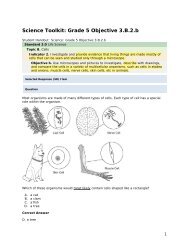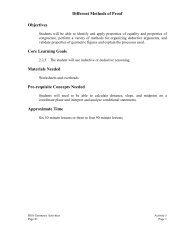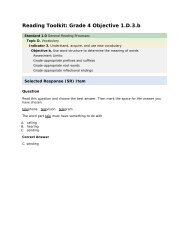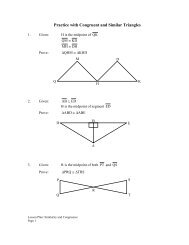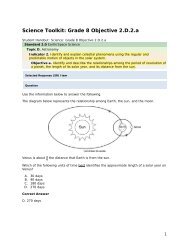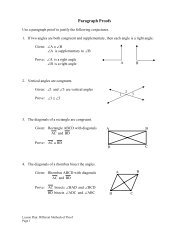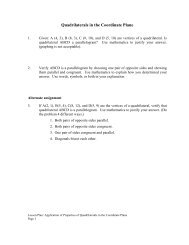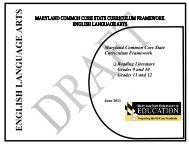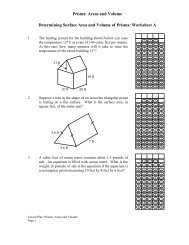x Perimeter and Area of Similar Figures - mdk12
x Perimeter and Area of Similar Figures - mdk12
x Perimeter and Area of Similar Figures - mdk12
Create successful ePaper yourself
Turn your PDF publications into a flip-book with our unique Google optimized e-Paper software.
<strong>Perimeter</strong> <strong>and</strong> <strong>Area</strong> <strong>of</strong> <strong>Similar</strong> <strong>Figures</strong><br />
1. The rectangles below are similar.<br />
A<br />
B<br />
M<br />
N<br />
3 x<br />
D<br />
9<br />
C<br />
P<br />
6<br />
O<br />
a. What is the similarity ratio <strong>of</strong> rectangle ABCD to rectangle MNOP? Simplify<br />
your ratio.<br />
b. What is the value <strong>of</strong> x? Use mathematics to explain how you determined your<br />
answer. Use words, symbols, or both in your explanation.<br />
c. What is the perimeter <strong>of</strong> each rectangle?<br />
d. What is<br />
<strong>Perimeter</strong> <strong>of</strong> rectABCD<br />
? Simplify your ratio.<br />
<strong>Perimeter</strong> <strong>of</strong> rectMNOP<br />
2. The isosceles triangles below are similar.<br />
E<br />
H<br />
6<br />
x<br />
J<br />
I<br />
8<br />
G<br />
F<br />
16<br />
a. What is the similarity ratio <strong>of</strong> triangle EFG to triangle HIJ? Simplify your<br />
ratio.<br />
b. What is the value <strong>of</strong> x? Use mathematics to explain how you determined your<br />
answer. Use words, symbols, or both in your explanation.<br />
c. What is the perimeter <strong>of</strong> each triangle? (Hint: use Pythagorean Theorem). Use<br />
mathematics to explain how you determined your answer. Use words,<br />
symbols, or both in your explanation.<br />
d. What is <strong>Perimeter</strong> <strong>of</strong> Δ EFG ?<br />
<strong>Perimeter</strong> <strong>of</strong> ΔHIJ<br />
Simplify your ratio.<br />
Lesson Plan: <strong>Area</strong> <strong>and</strong> Volume <strong>of</strong> <strong>Similar</strong> <strong>Figures</strong><br />
Page 1
<strong>Perimeter</strong> <strong>and</strong> <strong>Area</strong> <strong>of</strong> <strong>Similar</strong> <strong>Figures</strong> (Continued)<br />
3. Circle A <strong>and</strong> circle B are similar.<br />
a. What is the similarity ratio <strong>of</strong> circle A<br />
to circle B?<br />
A<br />
5<br />
B<br />
2<br />
b. What is the circumference <strong>of</strong> each circle? Leave answers in terms <strong>of</strong> .<br />
c. What is<br />
Circumference <strong>of</strong> circle A<br />
? Simplify your ratio.<br />
Circumference <strong>of</strong> circle B<br />
4. What is the relationship between the ratio <strong>of</strong> the sides <strong>of</strong> the similar figures <strong>and</strong> the<br />
ratio <strong>of</strong> their perimeters or circumferences?<br />
5. These rectangles (from problem 1) are similar.<br />
A<br />
D<br />
a. What is the similarity ratio <strong>of</strong> rectangle ABCD to rectangle MNOP?<br />
b. What is the area <strong>of</strong> each rectangle?<br />
9<br />
B M<br />
N<br />
3 x<br />
C<br />
P<br />
6<br />
O<br />
c. What is <strong>Area</strong> <strong>of</strong> rectABCD ?<br />
<strong>Area</strong> <strong>of</strong> rectMNOP<br />
Simplify your ratio.<br />
6. These isosceles triangles (from problem 2) are similar.<br />
E<br />
H<br />
G<br />
16<br />
6<br />
F<br />
J<br />
8<br />
x<br />
I<br />
a. What is the similarity ratio <strong>of</strong> triangle EFG to triangle HIJ?<br />
b. What is the area <strong>of</strong> each triangle?<br />
c. What is <strong>Area</strong> <strong>of</strong> Δ EFG ? Simplify your ratio.<br />
<strong>Area</strong> <strong>of</strong> ΔHIJ<br />
Lesson Plan: <strong>Area</strong> <strong>and</strong> Volume <strong>of</strong> <strong>Similar</strong> <strong>Figures</strong><br />
Page 2
<strong>Perimeter</strong> <strong>and</strong> <strong>Area</strong> <strong>of</strong> <strong>Similar</strong> <strong>Figures</strong> (Continued)<br />
7. Circle A <strong>and</strong> circle B (from problem 3) are similar.<br />
a. What is the similarity ratio <strong>of</strong> circle A<br />
to circle B?<br />
b. What is the area <strong>of</strong> each circle? Leave the<br />
answers in terms <strong>of</strong> .<br />
A<br />
5<br />
B<br />
2<br />
c. What is<br />
<strong>Area</strong> <strong>of</strong> circle A<br />
? Simplify your ratio.<br />
<strong>Area</strong> <strong>of</strong> circle B<br />
8. What is the relationship between the ratio <strong>of</strong> the sides <strong>of</strong> the similar figures <strong>and</strong> the<br />
ratio <strong>of</strong> their areas?<br />
9. Fill in the blank.<br />
If two similar polygons or circles have lengths <strong>of</strong> corresponding sides (or radii) in<br />
the ratio <strong>of</strong> a , then their areas are in the ratio <strong>of</strong> ________.<br />
b<br />
Lesson Plan: <strong>Area</strong> <strong>and</strong> Volume <strong>of</strong> <strong>Similar</strong> <strong>Figures</strong><br />
Page 3
Answers: 1. a.<br />
9<br />
6 or 3 9 3<br />
b. = , x = 2<br />
2<br />
6 x<br />
c. P (ABCD) = 24 <strong>and</strong> P (MNOP) = 16<br />
d.<br />
24<br />
16 or 3 2<br />
2. a.<br />
16<br />
8 or 2 16 6<br />
b. = , x = 3<br />
1<br />
8 x<br />
Lesson Plan: <strong>Area</strong> <strong>and</strong> Volume <strong>of</strong> <strong>Similar</strong> <strong>Figures</strong><br />
Page 4<br />
2 2<br />
c. 6 + 8 = ( EG) 2<br />
3 2 + 4 2 = ( HJ) 2<br />
EG = EF = 10 HJ = HI = 5<br />
Δ EFG : P = 10 + 10 + 16 = 36<br />
Δ HIJ : P =5 + 5 + 8 = 18<br />
d.<br />
36<br />
18 or 2 1<br />
3. a.<br />
5<br />
2<br />
b. A = 2(5) = 10 B = 2(2) = 4<br />
c.<br />
10π<br />
4π 2<br />
4. The ratio <strong>of</strong> the sides is the same as the ratio <strong>of</strong> the perimeters<br />
(circumferences).<br />
5. a.<br />
3<br />
2<br />
b. A (ABCD) = 9(3) = 27 A (MNOP) = 6(2) = 12<br />
c.<br />
27<br />
12 or 9 4<br />
6. a.<br />
2<br />
1<br />
1 1<br />
b. Δ EFG : ( 16 )( 6 ) = 48 Δ HIJ : ()() 8 3 = 12<br />
2<br />
2<br />
c.<br />
48<br />
12 or 4 1<br />
7. a.<br />
5<br />
2<br />
b. A = π ( 5) 2<br />
= 25 B = ( 2) 2<br />
π = 4<br />
25π<br />
25<br />
c. or<br />
4π 4<br />
8. The ratio <strong>of</strong> the areas <strong>of</strong> the similar figures equals the square <strong>of</strong><br />
the ratio <strong>of</strong> the sides.
9. If two similar polygons or circles have lengths <strong>of</strong><br />
corresponding sides (or radii) in the ratio <strong>of</strong> a , then their areas<br />
b<br />
are in the ratio <strong>of</strong><br />
2<br />
2<br />
a<br />
2<br />
b or ⎛a<br />
⎞<br />
⎜ ⎟<br />
⎝b<br />
⎠ .<br />
Lesson Plan: <strong>Area</strong> <strong>and</strong> Volume <strong>of</strong> <strong>Similar</strong> <strong>Figures</strong><br />
Page 5


